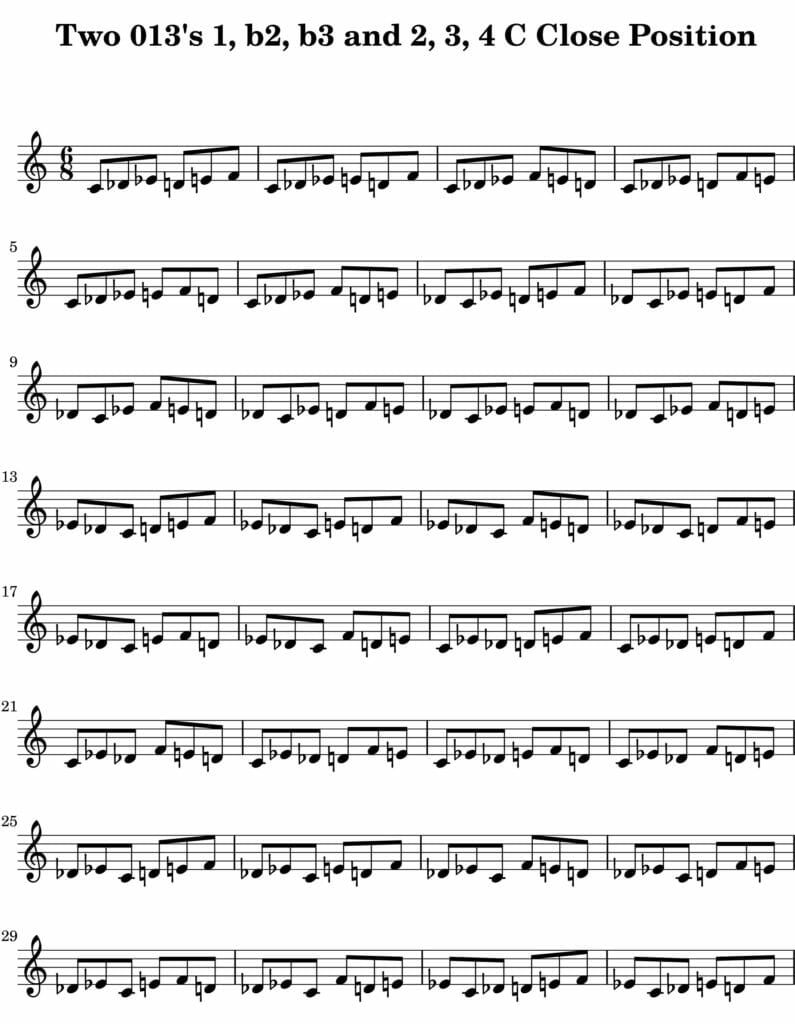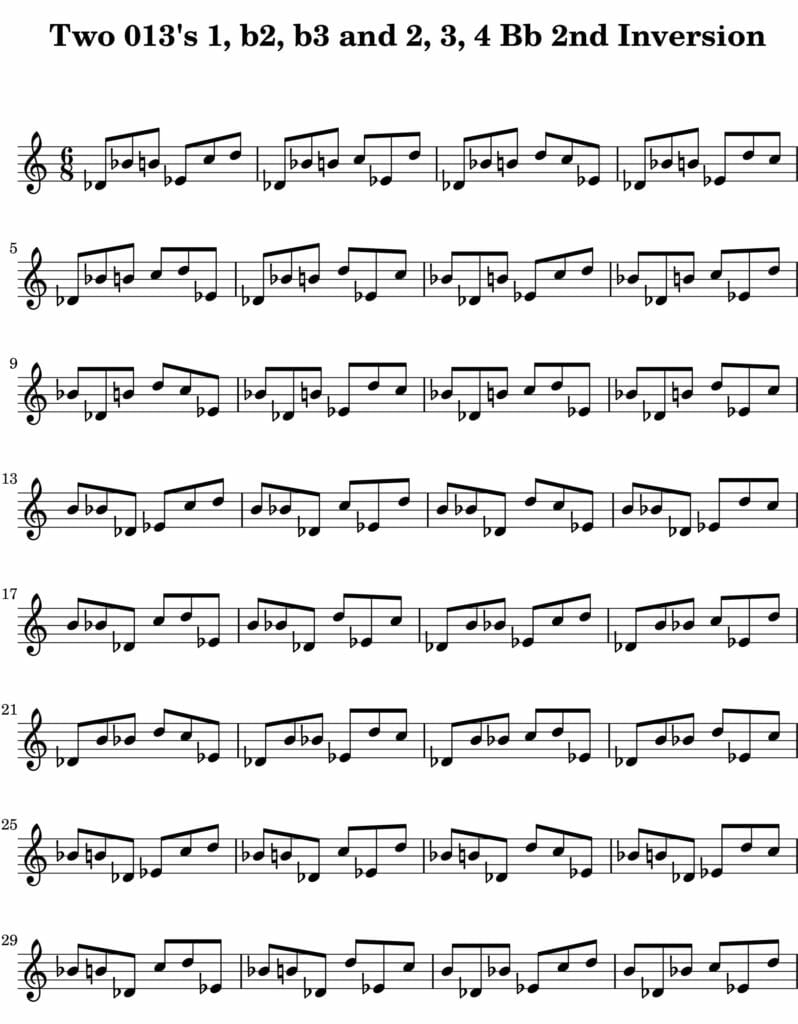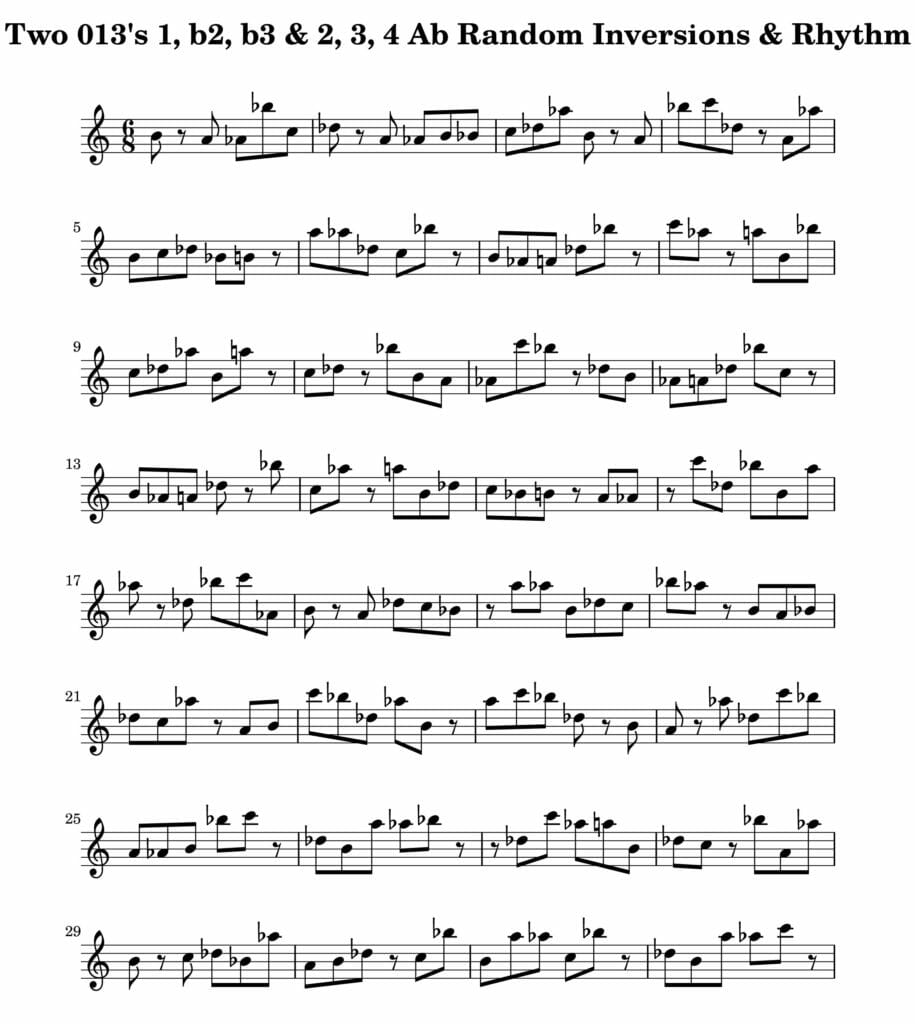
Harmonic and Melodic Equivalence V1
Harmonic and Melodic Equivalence V1
Status: In stock, Digital book is available for immediate access.
Melodic Rotations Learning to Improvise More Based on the Composition
"Harmonic and Melodic Equivalence" is a series of books that will help you to develop many different musical skills simultaneously. The source materials for these books are exercises that contain two 3 note groupings, also called "trichords," that are manipulated in various ways. These exercises use many different types of harmonic and melodic ideas that can be superimposed over common chord progressions, scales and other musical situations. The exercises found in these courses are also great for singing and rhythm studies. Finally, the "Harmonic and Melodic Equivalence" course concentrates on the use of the three note pitch class sets (trichords) by pairing each trichord with another trichord with the same prime form. For instance, C, Db, Eb and D, E, F are both 013 pitch class sets because they both contain a 1/2 step and a minor 3rd within their interval structure.
Harmonic and Melodic Equivalence Series
This course is part of the Harmonic and Melodic Equivalence Series which explores over 40 different three note pairs that I've used in compositions and improvisations. To see all volumes follow the link to explore each volume and hear examples from each course as well as finding links to compositions that I've written using each combination.
Harmonic and Melodic Equivalence Exercises
This course is divided up into two sets of exercises written in treble and bass clef. The 1st set of exercises gets gradually harder but also more musical. Depending upon your musical skills you can start anywhere you want but for beginners I would recommend starting from the 1st exercise of the five. The 2nd set of exercises are called "Atomic Scales." These exercises are a technical exercise that really helps you to learn these ideas but also sound great as a melody right off the bat. There are 6 different types of "Atomic Scales" exercises in this course. You don't have to play every exercise in every key. But doing this will greatly increase the likelihood of you using it in real music in the future. Below is a listing of the exercises found in this course:
- Closed position studies.
- 1st inversion studies.
- 2nd inversion studies.
- Random combinations of closed position along with 1st and 2nd inversion.
- Random combinations of closed position along with 1st and 2nd inversion with rhythmic displacement.
- Atomic Scales Exercise 1
- Atomic Scales Exercise 2
- Atomic Scales Exercise 3
- Atomic Scales Exercise 4
- Atomic Scales Exercise 5
- Atomic Scales Exercise 6
- Closed position studies are an excellent way to get a foothold into the sound of these two 3 note groups moving back and forth. Along with playing them on your instrument, I also recommend using a drone in the background to help you hear the key center. It is a good idea to sing through these melodies, again with a drone in the background. Any instrument could be used as a drone but I recommend using the MetroDrone® app or MP3's as your source. 12 MP3s from the MetroDrone® are included with this course. Initially you wouldn't have to play or sing any exercise in time but that would be your ultimate goal. Once you reach the level of playing or singing these melodies in time I highly recommend you get the full version of the MetroDrone® so that you can work at all tempos in all keys.
- The 1st Inversion studies open up the 3 note group to a large melodic leap. While initially this might not seem very musical, later on when you work with levels 4 and 5 studies you will see these leaps are very useful in making a coherent melodic line. These leaps can also be a challenge to play and sing so they are an excellent source for developing this side of your musicianship. The singing of 1st inversion and the forthcoming 2nd inversion exercises helps you hear the 3 note group in any configuration and prepare you for how it will be found in real music.
- The 2nd inversion studies completes the three possible ways to play the 3 notes groups within one octave. Like the 1st inversion they are excellent to develop your physical ability and singing these melodies will extend your technical and aural skills.
- The 4th exercise where random combinations of closed position, 1st and 2nd inversion are used gets you much closer to how these melodies would sound when used with real music. The one drawback is the constant stream of eighth notes which would certainly need further editing to make consistent musical melodic lines. This 4th exercise is really just a preparation for the 5th exercise which will introduce rests. By introducing rests the melodies become much more musical but also much harder to play because of the shifting rhythms. This is why the 4th exercise is a good stepping stone for the 5th. Singing these melodies with a drone is also recommended.
- The last level introduces syncopation to the random combinations of closed position, 1st and 2nd inversions. This is by far the most musical of the five exercises but also the most challenging. If you have good technical skills as well as sight reading chops, I recommend going to this exercise first, so that you can hear how the combination of C, Db, Eb and D, E, F will sound in a melodic line. Use the MetroDrone® or other jam tracks to explore how this combination sounds in different contexts.
- Three octave sequences that move back and forth between the two 3 note groups in the ABC sequence
- Three octave sequences that move back and forth between the two 3 note groups in the ACB sequence
- Three octave sequences that move back and forth between the two 3 note groups in the BAC sequence
- Three octave sequences that move back and forth between the two 3 note groups in the BCA sequence
- Three octave sequences that move back and forth between the two 3 note groups in the CAB sequence
- Three octave sequences that move back and forth between the two 3 note groups in the CBA sequence






-

- <




- How to Use This Course
- Harmonic/Melodic Possibilities of Two 013's
- Chord Possibilities of Two 013's
- Rotations Starting on Every Eighth Note
- Two 013's in Modal Playing
- How to Think of the 013's Used in This Course
- 013 Daily Exercise-Atomic Scales
- Thinking of the Trichords as Modes
- Thinking of the Trichords as One Scale
- C, Db, Eb and D, E, F as One Scale in All Keys
- Digital Edition 978-1-59489-331-5
- One 8 page PDF explaining exercises, 5 different types of exercises, 328 pages of exercises in PDF format in treble and bass clef
- MP3's and Midi files for all exercises.
- 12 MP3s from Tuba MetroDrone®
Explanation of 1st Set of Exercises in Harmonic and Melodic Equivalence V1 Course
Below is an explanation for each set of the 5 different exercises found in this course. All exercises include MP3s as well as midi files so that you can hear and play these exercises at any tempo as well as versions in all 12 keys.
Explanation of 2nd Set of Exercises in Harmonic and Melodic Equivalence V1 Course
Below is an explanation for each set of the 6 different atomic scale exercises found in this course. Three octave sequences that move back and forth between the two 3 note groups are presented in six different configurations. These exercises are highly melodic and can be used verbatim as melodies when soloing. If we thought of the three notes as A,B,C then there would be six different ways to combine these notes. i.e. ABC, ACB, BAC, BCA, CAB and CBA. All exercises include MP3s as well as midi files so that you can hear and play these exercises at any tempo as well as versions in all 12 keys.
1st Set of Exercises in Harmonic and Melodic Equivalence V2 Course
Here are a few examples from the 1st set of exercises.
Closed Position Exercise
At Slower Tempo
https://s3.amazonaws.com/media.muse-eek.com/mp3/HandMEV1/01_013_Key_C.mp3
At Faster Tempo
https://s3.amazonaws.com/media.muse-eek.com/mp3/HandMEV1/01_013_Key_C_Fast.mp3
1st Inversion Exercise
At Slower Tempo
https://s3.amazonaws.com/media.muse-eek.com/mp3/HandMEV1/02_013_Key_F.mp3
At Faster Tempo
https://s3.amazonaws.com/media.muse-eek.com/mp3/HandMEV1/02_013_Key_F_Fast.mp3
2nd Inversion Exercise
At Slower Tempo
https://s3.amazonaws.com/media.muse-eek.com/mp3/HandMEV1/03_013_Bb.mp3
At Faster Tempo
https://s3.amazonaws.com/media.muse-eek.com/mp3/HandMEV1/03_013_Bb_Fast.mp3
Random combinations of closed position along with 1st and 2nd inversion.
At Slower Tempo
https://s3.amazonaws.com/media.muse-eek.com/mp3/HandMEV1/04_013_Eb.mp3
At Faster Tempo
https://s3.amazonaws.com/media.muse-eek.com/mp3/HandMEV1/04_013_Key_Eb_Fast.mp3
Random combinations of closed position along with 1st and 2nd inversion and rhythm permutation
At Slower Tempo
https://s3.amazonaws.com/media.muse-eek.com/mp3/HandMEV1/05_013_Key_Ab.mp3
At Faster Tempo
https://s3.amazonaws.com/media.muse-eek.com/mp3/HandMEV1/05_013_Key_Ab_Fast.mp3
2nd Set of Exercises in Harmonic and Melodic Equivalence V1 Course
Here are a few examples from the 2nd set of exercises.
Atomic Scales 1st Rotation
MP3 example
https://s3.amazonaws.com/media.muse-eek.com/mp3/HandMEV1/01_013_Degree_1_b2_b3_2_3_4_Atomic_Scale_Ex_1_Key_C.mp3
Atomic Scales 2nd Rotation
MP3 example
https://s3.amazonaws.com/media.muse-eek.com/mp3/HandMEV1/02_013_Degree_1_b2_b3_2_3_4_Atomic_Scale_Ex_2_Key_F.mp3
Atomic Scales 3rd Rotation
MP3 example
https://s3.amazonaws.com/media.muse-eek.com/mp3/HandMEV1/03_013_Degree_1_b2_b3_2_3_4_Atomic_Scale_Ex_3_Key_Bb.mp3
Atomic Scales 4th Rotation
MP3 example
https://s3.amazonaws.com/media.muse-eek.com/mp3/HandMEV1/04_013_Degree_1_b2_b3_2_3_4_Atomic_Scale_Ex_4_Key_Eb.mp3
Atomic Scales 5th Rotation
MP3 example
https://s3.amazonaws.com/media.muse-eek.com/mp3/HandMEV1/05_013_Degree_1_b2_b3_2_3_4_Atomic_Scale_Ex_5_Key_Ab.mp3
Atomic Scales 6yh Rotation
MP3 example
https://s3.amazonaws.com/media.muse-eek.com/mp3/HandMEV1/06_013_Degree_1_b2_b3_2_3_4_Atomic_Scale_Ex_6_Key_Db.mp3
TOC for Harmonic and Melodic Equivalence V1 Course:
Get Harmonic and Melodic Equivalence Today!
Status: In stock, Digital book is available for immediate access.
Additional Information for Harmonic and Melodic Equivalence V1:
What people are saying:
I'm looking forward to digging into these Harmonic and Melodic Equivalence courses. They are bit size windows into the use of 3 note groupings over many musical situations. I'm inspired already! J. Ogland
I own most of Mr. Arnold's pitch class set books. This series really goes to the heart of Mr. Arnold's explorations in this field. I like that it explores just one region at a time but also gives you enough information to dig deeper if you so desire. K. Franklin
This is one of the few places I've found where there are exercises that aren't just a series of eighth notes void of rhythm. While there are some exercises like that in this book the level 5 exercises incorporate rhythm which is essential in making musical sense out of these ideas. I also love the fact that there are midi files for every exercise. That is very helpful! W. Harris
Hey Bruce, greatly appreciate you including the bass clef versions of these exercises in the course. I hate it when you have to buy a separate book just to get the bass clef exercises. I play bass and guitar so you can see my dilemma. I love the ideas you present in this book. Real nuts and bolts applications of materials that are usually thought of as avant garde. Using 013's as a V7 to I progression. Brilliant! A. Wadsworth


